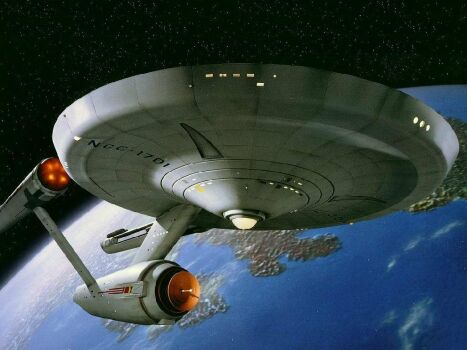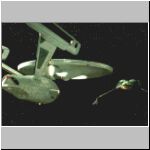|
The United Federation of Planets.
Founded in 2161, the United Federation of Planets, began as an interstellar alliance of colonies and interplanetary governments.
The common goal of the UFP is mutual trade, exploratory research, scientific endeavors, cultural and diplomatic exchanges, and defense measures. To date, there are over 150 member planets spread over 8,000 light-years.
The UFP is governed over by the Federation Council, composed of members from various member planets and colonies. The Council is presided over by the Federation President, whose office can be found in Paris, France, on planet Earth.
The UFP's guidelines are set about in the Constitution of the United Federation of Planets. This historic document, written in 2161, outlines the framework by which the Federation is governed.
Starfleet.
Starfleet is an organization chartered by the UFP, dedicated to exploration, diplomacy, research, and defense. It is not primarily a military service in the 20th century sense of the term.
|
 U.S.S.Enterprise NCC-1701
Perhaps the most famous spacecraft in the history of space exploration, the original U.S.S.Enterprise was a Constitution Class vessel, registry number NCC-1701.
U.S.S.Enterprise NCC-1701
Perhaps the most famous spacecraft in the history of space exploration, the original U.S.S.Enterprise was a Constitution Class vessel, registry number NCC-1701.
Launched in 2245 from the San Francisco Yards orbiting Earth, the Enterprise was first commanded by Captain Robert April, then by Captain Christopher Pike. Superbly equipped for research in deep space, the Enterprise had 14 science labs. The ship achieved legendary status during the five-year mission commanded by Captain James T. Kirk from 2264 to 2269. The original Starship Enterprise was refitted several times during its lifetime, most notably in 2270, when virtually every major system was upgraded, a new bridge module was installed, and the warp drive nacelles were replaced.
The ship was destroyed by James Kirk in 2285, just prior to its scheduled retirement, in order to prevent the ship from falling into Klingon hands during a rescue mission to recover the body of Captain Spock. |
|
Star Trek...as a hobby.
The study of Star Trek is called "Treknology", which means that I'm a "Treknologist", because that's what I do, my hobby is Treknology. It's a very wide field of study, covering subjects like Federation and Starfleet, Equipment & Technology, Federation Starships, Non-Federation Vessels, Other Worlds & Races,not to mention the people.As you can see, there's a lot to learn, and it's all very facinating. I have access to lots of different types of source material, the primary one being of course my collection of video's of the TV episodes, and the movies on DVD. I also subscribe to a weekly publication of Star Trek Fact Files, which is a must for any serious fan. Then there's the interactive CD-Rom Star Trek Encyclopedia, which can tell you everything you ever wanted to know about Star Trek but were too afraid to ask.
|
|
The Enterprise-A
The second Federation starship to bear the name, the Enterprise-A was a Constitution-class vessel, registry number NCC-1701-A. Launched in 2286, the Enterprise-A was placed under the command of Captain James T.Kirk by the Federation Council in appreciation of Kirk's role in saving planet Earth from the destructive effects of an alien space probe. Although shakedown tests and systems installation under the aegis of Captain Montgomery Scott had not been completed, the Enterprise-A was rushed into service in early 2287 to intervene in a hostage situation on the planet Nimbus III. The ship, under the reluctant command of Captain Kirk, was pressed back into service to escort Klingon Chancellor Gorkon to Earth for a peace conference. Although the scheduled talks were cancelled after the assassination of Gorkon, the Enterprise-A and her crew were instrumental in the success of the historic Khitomer peace conference shortly thereafter. The Enterprise-A was scheduled to be decommissioned shortly after the Khitomer conference.
The Enterprise-B
Federation starship, Excelsior-class, Starfleet registry number NCC-1701-B, the third starship to bear the name. The Enterprise-B was launched from a spacedock orbiting Earth in 2293, with Captain John Harriman in command. Its maiden voyage was planned as a publicity junket consisting of a brief trip out past Pluto. Dignitaries aboard the Enterprise-B for the occasion included Captain James T.Kirk, Captain Montgomery Scott, and Commander Pavel Chekov. During this flight, the Enterprise-B responded to an emergency distress call from two El-Aurian transport ships en route to Earth. The ships were trapped in the Nexus energy ribbon and were on the verge of structural collapse. Problems with the Enterprise-B equipment prevented the rescue of one El-Aurian ship, but some 47 passengers from the second ship, the S.S.Lakul, were transported to safety just before the Lakul exploded. Among those rescued were scientist Dr.Tolian Soran and future Enterprise-D crew member Guinan. Captain James T.Kirk was missing and believed killed in the incident. Kirk had been making emergency modifications to the Enterprise-B deflector system, permitting the ship to escape the ribbon. It was later learned that Kirk had not been killed, but rather, had been swept into the Nexus.
Continue to Enterprise-C
|
 NCC-1701-A
NCC-1701-A
|
NCC-1701-B
|


